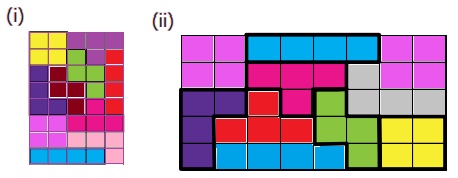Information Processing | Term 1 Chapter 6 | 7th Maths - Tetromino | 7th Maths : Term 1 Unit 6 : Information Processing
Chapter: 7th Maths : Term 1 Unit 6 : Information Processing
Tetromino
Tetromino
To know about tetromino, it is essential to have
an idea about Domino and Trinomino.
Join two squares of size 1cm × 1cm edge to edge. Such
formation is called as Domino. When we arrange Domino either horizontally or vertically we
get the following shapes 
Similarly, when we join three squares along their
edges we get the formation called Trinomino.
When we arrange horizontally or vertically we get the following shapes 
Is this the only way to join the three squares ?
No, we get four different orientations of shape as shown 
Try to join four squares either horizontally or
vertically as we did for Domino and Trinomino, then we get the following shapes  Is there any other way of joining four squares. Yes, let us learn about them.
Is there any other way of joining four squares. Yes, let us learn about them.
Situation 1
The teacher divide the students into five groups
and gives each group 20 square (of size 1
cm × 1 cm) tokens. Then ask them to
form different shapes using the four square tokens and compare the shapes created
by all groups. Draw the common shapes on the blackboard.

How many shapes do we get ?
Only five shapes, isn’t it?
When we rotate these shapes, we get all the other
shapes as shown below :

Thus, all the formation of four squares
formed by joining edge to edge are called “ TETROMINOES ” .
The word “ Tri” means three. Joining
three squares is called "Trinomino".
The word “ Tetra” means four. Joining
four squares is called "Tetromino".
Use the given five tetrominoes only
once and create the shape given below.

1.
Filling rectangular tiles using Tetrominoes
Situation 2
Can you form the rectangles of same area using the
five tetrominoes only once? No, observe the following formations (Fig 6.9 – 6.12) where we have arranged tetrominoes edge to edge
and tried to fill in rectangles. The boxes marked X
are not filled by a tetromino. Hence the rectangle is incomplete. Also, some squares
protrude outside the boundary of the rectangle.
The five tetrominoes together consist of 20 squares.
Using 20 squares we can form the rectangles of size 1 × 20, 20 × 1, 2 × 10, 10 ×
2, 4 × 5, and 5 × 4.

Why we are not able to form rectangular shapes using
these tetrominoes only ones?.
To know the reason, take the five tetrominoes in
the form shown below.

From among the five tetrominoes, in four of them,
the number of shaded and unshaded squares are equal. But, in one tetromino  , the shaded and unshaded squares are not equal. Hence, it is impossible to fit
the tetrominoes in the rectangle using it only once.
, the shaded and unshaded squares are not equal. Hence, it is impossible to fit
the tetrominoes in the rectangle using it only once.
However, If we use all the five tetrominoes twice,
rectangles of sizes 5 × 8 , 4 × 10 and so on.
It can be completely filled in, as shown in Fig. 6.14 and Fig.6.15.

This concept will be useful in many places in real
life situation like tiling a floor, packing things in a box and so on.
Try these
1. Complete the rectangles given below using the five tetrominoes
only once.

Answer:

2. In Fig 6.16 one 4 × 4 square is filled by a tetromino shape ‘ ’. In the same way try to fill the other 4 × 4 square grids (Fig.6.17 to Fig.6.20)
using the other four tetrominoes (
’. In the same way try to fill the other 4 × 4 square grids (Fig.6.17 to Fig.6.20)
using the other four tetrominoes (  ). Find which tetromino shape
cannot fill the 4 × 4 square grid completely.
). Find which tetromino shape
cannot fill the 4 × 4 square grid completely.

Answer:

Example 6.1
Find the tetromino shapes found in the showcase
given in Fig.6.21 below. Form the same shape in the geoboard using rubberbands.

Solution

Example 6.2
Raghavan wants to change the front elevation of
his house using the tiles made up of tetromino shapes 
1. How many tetrominoes are there in a tile  ?
?
2. If the cost of a square tile is ₹ 52 then what
will be the cost of the tiles that Raghavan buys for the front elevation? (see Fig.
6.22)

Solution
1.

Therefore, there are nine tetrominoes in a tile.
2. Given, the cost of a tile is ₹ 52
There are six tiles in the front elevation
Therefore, the total cost = 6 × 52 = ₹ 312
Related Topics